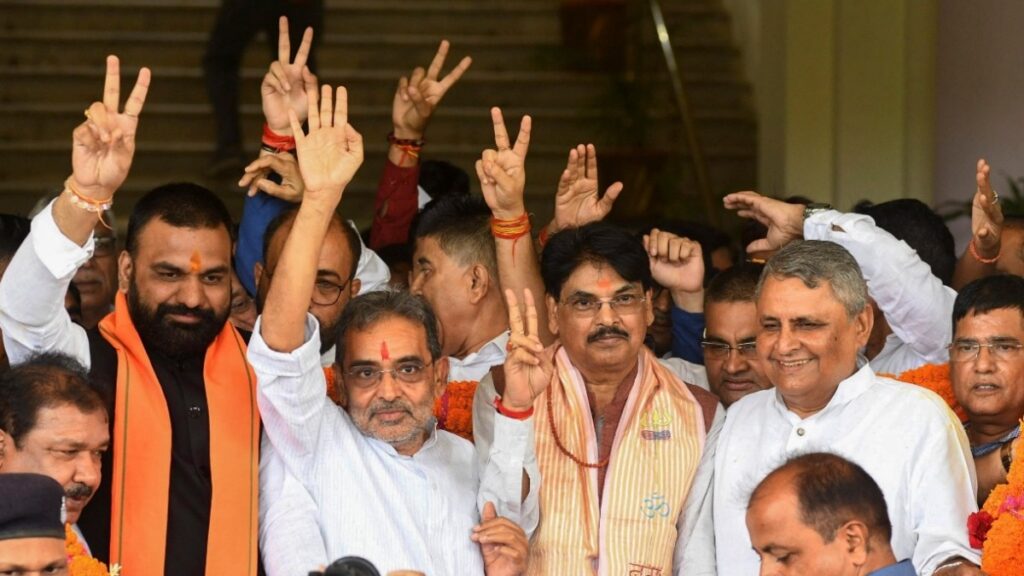NDA has got majority in Rajya Sabha. The reason is, all the candidates have been elected unopposed even before the by-elections on 12 seats of 9 states. All these candidates have won two seats each in Assam, Bihar and Maharashtra and one seat each in Haryana, Madhya Pradesh, Rajasthan, Tripura, Telangana and Odisha. Among them, 9 members of BJP, one from Congress, one from NCP (Ajit Pawar) and one from Rashtriya Lok Morcha have been elected. With this, the figure of NDA in Rajya Sabha has touched the majority with the support of nominated and independent members.
In fact, 12 seats were vacant due to the election of Kamakhya Prasad Tasha and Sarbananda Sonowal in Assam, Misa Bharti and Vivek Thakur in Bihar, Deepender Hooda in Haryana, Jyotiraditya Madhavrao Scindia in Madhya Pradesh, Chhatrapati Udayan Raje Bhosale and Piyush Vedprakash Goyal from Maharashtra, KC Venugopal from Rajasthan and Biplab Dev from Tripura as Lok Sabha members and the resignation of Keshav Rao of Telangana and Mamata Mohanta of Odisha. The tenure of the elected outgoing members will be till 2028.
BJP’s number in Rajya Sabha increased to 96
After the unopposed election on 12 seats, the number of BJP in Rajya Sabha has now increased to 96. If we talk about the number of NDA, it has also increased to 112. Eight more seats are still vacant in the 245-member Rajya Sabha. These include four seats of Jammu and Kashmir and four seats of nominated members. In this way, the majority figure in Rajya Sabha at present is 119 members. NDA also has the support of six nominated and one independent and in this way NDA has touched the majority figure.
According to experts, now BJP will not have to depend on BJD, YSR Congress, BRS and AIADMK to get any important bill passed in Rajya Sabha. On the other hand, Congress’s seat of Leader of Opposition in Rajya Sabha will also remain safe. Congress’s number in Rajya Sabha has increased by one to 27, which is two more than the 25 seats required for the post of Leader of Opposition.
Elections were to be held on all seats on September 3
Let us tell you that the Election Commission had issued a notification for the Rajya Sabha by-election this month. The last date for filing nomination papers was 21 August and the last date for withdrawal of nomination was 27 August. Voting was to be held in the respective state assemblies on September 3 from 9 am to 4 pm and counting of votes would be done from 5 pm the same evening and the results were to be declared by night. But on the last date for withdrawal of nomination i.e. 27 August, the candidates were elected unopposed on all 12 seats.
What was the status of these 12 seats earlier
Out of the 12 seats on which members have been elected, the maximum number of 7 Rajya Sabha MPs were from BJP. After that, Congress had 2, BRS, BJD and RJD had one MP each. BJP had two seats each in Assam-Maharashtra, one seat each in Madhya Pradesh, Bihar, Tripura. Congress had one seat each in Haryana-Rajasthan and RJD had one seat in Bihar. Similarly, BRS had one Rajya Sabha MP in Telangana and BJD had one seat in Odisha. In Telangana, K. Keshavraj left BRS and joined Congress in July. While Odisha’s Mamta Mohanta also left BJD some time ago and joined BJP.
What is the procedure for getting elected as a Rajya Sabha MP?
In the Rajya Sabha elections, MLAs from all the state assemblies participate. Members of the Legislative Council do not vote in it. There is a voting formula for Rajya Sabha elections. To understand the selection process, you will have to understand the +1 formula. To understand this process, we take the example of Uttar Pradesh. Actually, 1 is added to the number of Rajya Sabha seats that are vacant in the state. Then it is divided by the total number of assembly seats. The number that comes out of this is then added by 1.
Understand it like this, if voting is to be held for 10 Rajya Sabha seats in a state. If 1 is added to it, this number will become 11. Now the number of assembly seats will be seen. If there are 399 MLAs in that state, then it will be divided by 11. In this case, the number will be 36.272. It will be considered as 36. Now if 1 is added to it, the number will become 37. That means, to win one Rajya Sabha seat, votes of 37 MLAs will be needed. For Rajya Sabha elections, all MLAs do not vote for all the candidates. An MLA can vote only once. They have to tell who is their first choice and who is their second choice.
How is the number of Rajya Sabha MPs decided?
There are 250 members in Rajya Sabha. Out of these, 238 members are elected. The remaining 12 members are nominated by the President. How many Rajya Sabha members will be there from which state is decided on the basis of its population.
Source (PTI) (NDTV) (HINDUSTANTIMES)
